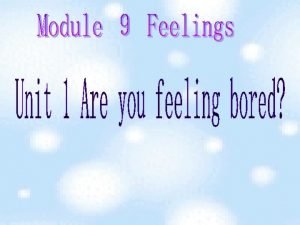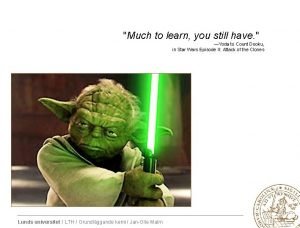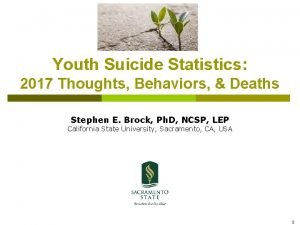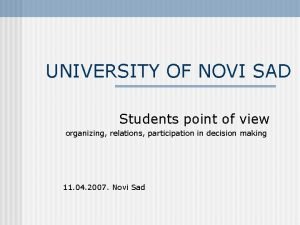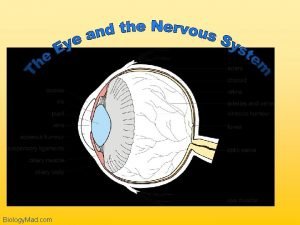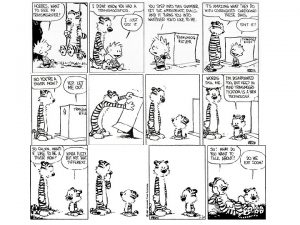Im sad mad and traumatized and you still

































- Slides: 33

“I’m sad, mad and traumatized… and you still want me to learn? ” Presented by: Dr. Bryan Pearlman

Do you agree with this? What does that mean to you? Do your staff members know this? You have superhero powers – to be able to help a child to be a success story and change their life trajectory!

Welcome & Introductions Dr. Bryan Pearlman 20+ years as school admin, non-profit & mental health Your Turn: Who are you? Name, school/job, hobby, what do you hope to gain today?

Something to think about “Children's talent to endure stems from their ignorance of alternatives. ” – Maya Angelou

Pre-Test for You 1. ) Trauma can impact school performance (True or False) 2. ) Trauma can impair learning (True or False) 3. ) Traumatized students may experience physical/emotional distress (True or False) 4. ) You can help a student who has been traumatized (True or False) 5. ) It is super easy to “fix” a traumatized student (True or False) 6. ) 1 out of every 4 children have been exposed to a traumatic event (True or False) 7. ) It is very easy to identify students who have been traumatized (True or False) 8. ) Keeping the attention of educators on a Monday after lunch is super easy (True or False)

Something to think about… “If we treat people as they are, we make them worse. If we treat people as they ought to be, we help them become what they are capable of becoming. ” ― Haim G. Ginott

A. W. There is a student who has and is enduring some major life challenges. She has seen things that we hope nobody ever has to see. She has been abused in many ways and completely neglected. I know her and her situation very well. She is passed back and forth to different caregivers. Best case scenario is that she believes her mom is very busy. A more likely scenario is that she knows that her mom does not care about her at all and does everything possible to have nothing to do with her. Adding to this situation is the fact that the other caregivers don’t care very much for her either. They feed her and put a roof over head (most nights), but they too want very little to do with her. Her home existence is one of little contact with others, no love or support. The little contact she gets is negative reinforcement – which includes a great deal of yelling, frustration, and punishments. She struggles with academics. She struggles with behaviors. She is very hard to manage in a school. She is dying for even the smallest amount of attention, love and kindness. Somehow this student gets out of bed, takes an hour bus ride to school, and walks into our building every day!

J. J. There was a boy named Justin. He was very little when two of his siblings died in a fire. Justin survived but had severe asthma as a result of exposure to inhaling a great deal of smoke. Mom fell out of the picture and grannie raised him and his cousins. In reality, the streets raised Justin was an explorer and a “frequent flyer” to the counselor and assistant principal’s office. Some of these visits were due to disrupting the class and others were daily stops on his wondering around the building tour. There were times when he would look pre-occupied or deep in thought. When asked about it, he either could not articulate what he was thinking or said he’d rather not speak about it. As difficult as Justin’s behaviors could be in class, there was something very likeable about Justin. He was a salesman, negotiator, and finagler. Justin had great eye contact, a big smile, and an infectious laugh. The day before winter break, Justin was sent to the office for being extremely disrespectful to a substitute teacher. The assistant principal lectured him and told him about how disappointed he was in Justin. The conversation went on to how many people were in Justin’s corner and how maybe Justin was just wasting there time if he wasn’t going to step up and do the right thing. Justin cried for the first time that anyone at school could remember. He promised that he would do better and that he was sorry for letting everyone down.

Justin A few days later on Christmas day, Justin had a severe asthma attack. He died in the ambulance on the way to the hospital. If Justin was still alive, he would be a sophomore in college.

Justin -I think about Justin every day! -I wondered if I could have one more day with Justin, what else we could have done to help him to succeed academically and with his behaviors. -I was mad at myself for yelling at him and making him cry. -I wish I understood then what I know about trauma and how it can impact a child and their behaviors! -I committed to sharing his story with as many people as I could and that is a big reason why I am here today speaking about trauma.

Define the Problem -What type of trauma can impact children? -What makes educating sad, mad and traumatized students difficult? -What behaviors do you see in your school? -How do your school staff (teachers, administrators, counselors…) deal with them? -How effective are these strategies? -What else gets in the way of helping the child? -If you had no policies or restrictions in public ed. , what would you do for the child?

Trauma Video Clip Nadine Burke Harris: How childhood trauma affects health across a lifetime https: //www. ted. com/talks/nadine_burke_harris_how_childhood_trauma_affects_health_across_a_lifetime ACES= Adverse Childhood Experiences Childhood trauma isn’t something you just get over as you grow up. Pediatrician Nadine Burke Harris explains that the repeated stress of abuse, neglect and parents struggling with mental health or substance abuse issues has real, tangible effects on the development of the brain. This unfolds across a lifetime, to the point where those who’ve experienced high levels of trauma are at triple the risk for heart disease and lung cancer. An impassioned plea for pediatric medicine to confront the prevention and treatment of trauma, head-on. Take the NPR ACES Quiz: https: //www. npr. org/sections/health-shots/2015/03/02/387007941/take-the-ace-quiz-and-learn-what-it-does-and-doesnt-mean

What can be done in your school to help students who are traumatized? -Create predictable routines in your classroom (also predictable reaction to their behaviors–outbursts, internalizing, etc. ) -Give choices – traumatic events involve loss of control/chaos. Kids feel safe when they have some control. -Increase the level of support/encouragement – designate an adult who can provide additional support if necessary. -Set clear, firm limits for inappropriate behavior and develop logical rather than punitive consequences. Don’t take offense to their outburst or behaviors (this has nothing to do with you!). Realize that there will be set-backs. Have realistic expect. for success. -Provide a safe place for the child to talk about what happened (designated time and place to share). -Be sensitive to cues in the environment that may cause a reaction (storms, emergency vehicles responding, etc. ) anticipate difficult times and provide additional support (upcoming court dates, stressful times of the school year, etc). -Warn children in advance if you will be doing something out of the ordinary (intruder drill, turning out lights, etc. ) -Look for ways to provide accommodations - not every traumatized child will meet criteria for an IEP, consider 504 or just best practices (shorten assignments, allow addi’ time, process for visiting designated adult, safe place, team plan for what to do if/when there is a significant behavioral outburst, etc. ). ------Fair isn’t always equal! -Team approach and outside resources…

Display classroom rules and expectations. Provide clear and concise instructions for academic assignments. Break complex instructions into small parts. Show students how to use an assignment book to keep track of their homework and daily assignments. Post a daily schedule and homework assignments in the same place each day. Tape a copy on the child's desk. Plan academic subjects for the morning hours. Provide regular and frequent breaks (movement breaks). Seat the child away from distractions and next to students who will be positive role models. Form small group settings when possible. Find a quiet spot in the classroom where students can go to do their work away from distractions. Have a partner room or critical adult friend where they can go if they are not in a good place. Help the child with transitions. Offer more positive reinforcements than negative consequences. Use negative consequences only after a positive reinforcement has enough time to become effective. Deliver negative consequences in a firm, business-like way without emotion or long-winded explanations. Think outside of the box and try many different strategies. Distracted or hyperactive behaviors

Allow the Student a 'Cool-Down' Break Ask Open-Ended Questions Assign a Reflective ‘Processing’ Essay After Misbehavior Do Not Get Entangled in Arguments Emphasize the Positive in Teacher Requests Expand the Range of Classroom Behavior Interventions Give Praise That is Specific and Does Not Embarrass the Student Give Problem Students Frequent Positive Attention Have the Student Participate in Creating a Behavior Plan Increase 'Reinforcement' Quality of the Classroom Keep Responses Calm, Brief, and Businesslike Listen Actively Offer the Student a Face-Saving Out Proactively Interrupt the Student’s Anger Early in the Escalation Cycle Project Calmness When Approaching an Escalating Student Relax Before Responding Reward Alternative (Positive) Behaviors State Teacher Directives as Two-Part Choice Statements Use a ‘Buddy Teacher’ for Brief Student Breaks Use Non-Verbal Behaviors to Defuse Potential Confrontations Use ‘Soft’ Reprimands Validate the Student’s Emotion by Acknowledging It Maladaptive Behaviors

Are All Traumatized Students The Same? Can They Have Other Concerns? Is there An Approach That Can Cover Multiple Concerns Beyond Trauma ? (i. e. Behaviors, Academics, At-Risk…)

SHOCKER APPROACH

What does SHOCKER stand for? Schoolwide team Hope Out of the box thinking Critical friend (captain of the team) Kindness and a kick in the pants Each and every child deserves a chance Response to intervention

Schoolwide Team Students who are struggling need a schoolwide team: -Create strategies for success -Involve the student in the planning -Come up with goals and methods for measuring success -Meet periodically to tweak plans

Hope Students who are struggling need hope that tomorrow will be better than today! Otherwise, why is it worth getting up in the morning and coming to school to fail. “By providing students in our Nation with such an education, we help save our children from the clutches of poverty, crime, drugs, and hopelessness. ” - Cummings

Out of the Box Thinking “In order to attain the impossible, one must attempt the absurd. ” – Miguel de Cervantes

Out of the Box Thinking (Examples) -Morning martial arts training, yoga or movement intervention -Mentors from the “real world” (police, fighter, business person…) -Give a difficult student a high level of responsibility/leadership/job -Counselor or Administrator – having lunch with difficult students for feedback on school -Mentor a much younger student -Double down on areas of strength (build success and have a quick win) -Get a “quick win” to build on

Critical Friend -Research was done to determine how someone became a doctor, lawyer, educator, or successful business person when they came from the highest at-risk group - 99 th percentile. (lowest socioeconomic group, incarcerated parent, high gang activity in the neighborhood, drugs in the household, etc. ) -The variable present in almost 100% of these people…. a “critical friend” – someone who would not let the student fail (neighbor, counselor, teacher, relative, etc. ). They “owned” them. -They become their de-facto case manager – monitoring progress towards goals.

Critical Friend -You can’t be this for every at-risk student, but someone in your building or community can be. -Each/every one of these struggling students need to be matched with someone who will not let them fail! -Face to face daily interactions is so powerful! (in the sales world – this is the #1 most effective strategy!) -Perhaps someone who had similar issues and is now a success.

Kindness & A Kick in the Pants -We always want to be kind, compassionate and caring with all students. This is a given. -Sometimes we have to “kick them in the pants” too (figuratively ). -Coach Pearlman at MMA was very different than Principal Pearlman. -Some think you can’t be both – but you definitely can. -They still need high expectations!!!

Each and every child deserves a chance “Every kid is one caring adult away from being a success story!” - Shipp

Response to Intervention -Determine skill deficiency -Locate intervention tool(s) to focus on deficient skill -Implement with fidelity -Monitor progress -Give it some time -Evaluate progress -If successful, keep going and if possible increase intensity -If unsuccessful, tweak intervention and try again -If repeatedly unsuccessful, gather group to brainstorm and determine next step(s).

Other Items to Think About Also applies to academics, attendance, behaviors, MENTAL HEALTH, etc… -Don’t give up (there will be set-backs and disappointments) -Expect resistance -Grit and determination -It took a while for the student to become who they are and where they are -The toughest kids – need us the most! -Don’t take it personally (kids will fight back)

Even More Things to Think About… -Teamwork Makes the Dream Work!!! You can’t do it by yourself – work with colleagues in the building to problem solve and to support the student (even the school secretary, custodian, SRO, food service, bus driver, etc. ). You are not alone. -Get creative and think way outside of the box. If the situation is a disaster, you likely won’t make it worse by trying crazy things. -The child/family may be doing the best that they know how to. -The more frustrating the situation gets the higher your empathy needs to get. -Suspensions and sending kids to the office are not typically very effective for kids with trauma, stress, anxiety or other underlying mental health issues. They make the situation worse when the child returns. -Best case – a parent wants to get their child in for therapy or possible medication – the wait time can be 3 months or more for a psychiatrist. Also, there is no magic pill to fix all. Even on medicine, it might get worse before it gets better. -These kids need you the most! -Never take the behaviors/actions personally – this is not about you!

Most schools focus on disruptive ---- what to do with those students that internalize and withdraw (sometimes under the radar)? Do you change your strategies? Should we be concerned about the traumatized student that is quiet and compliant?

Questions? ? ?

Additional Resources Other relevant resources When time doesn't heal all wounds | Dr. Robert K. Ross | TEDx. Ironwood. State. Prison https: //www. youtube. com/watch? v=ds. CNu. B_KBUw Children, Violence, and Trauma—Interventions in Schools https: //www. youtube. com/watch? v=49 Gzq. PP 7 YYk Through Our Eyes: Children, Violence, and Trauma—Introduction https: //www. youtube. com/watch? v=z 8 v. Zx. Da 2 KPM

Contact information Dr. Bryan Pearlman bpearlman@hazelwoodschools. org 314 -323 -7340 Twitter @Dr. P_Principal
 Sad happy bored
Sad happy bored Happy sad angry hungry
Happy sad angry hungry Happy sad angry hungry
Happy sad angry hungry Im sad mad
Im sad mad Stand still laddie
Stand still laddie Empirisk formel
Empirisk formel Hide me now under your wings
Hide me now under your wings Yet i show you a more excellent way
Yet i show you a more excellent way Breast tenderness early pregnancy
Breast tenderness early pregnancy Mean absolute deviation steps
Mean absolute deviation steps Tell me what you eat and i shall tell you what you are
Tell me what you eat and i shall tell you what you are The multimodal text big ed mona
The multimodal text big ed mona Do you love the rain
Do you love the rain Agree or disagree questions about life
Agree or disagree questions about life If you think you can you can poem
If you think you can you can poem I will follow you follow you wherever he may go
I will follow you follow you wherever he may go Ssd and sad technique in radiotherapy
Ssd and sad technique in radiotherapy Funny superlativo
Funny superlativo Juxtaposition literary definition
Juxtaposition literary definition Introduction of system analysis and design
Introduction of system analysis and design Gethsemane gethsemane o sad and dark gethsemane
Gethsemane gethsemane o sad and dark gethsemane Sad and embarrassed
Sad and embarrassed Cezanne still life
Cezanne still life Picasso still life with mandolin
Picasso still life with mandolin I hated tonto still do
I hated tonto still do Be still and know that i am god.
Be still and know that i am god. Captured dan discrete media
Captured dan discrete media Pain x mad
Pain x mad Fast and furious mad lib
Fast and furious mad lib Sad hopeless
Sad hopeless Sąd ozyrysa scenariusz lekcji
Sąd ozyrysa scenariusz lekcji Mood scared
Mood scared Farabi is flora's best friend
Farabi is flora's best friend Nikola cubrilo novi sad
Nikola cubrilo novi sad
